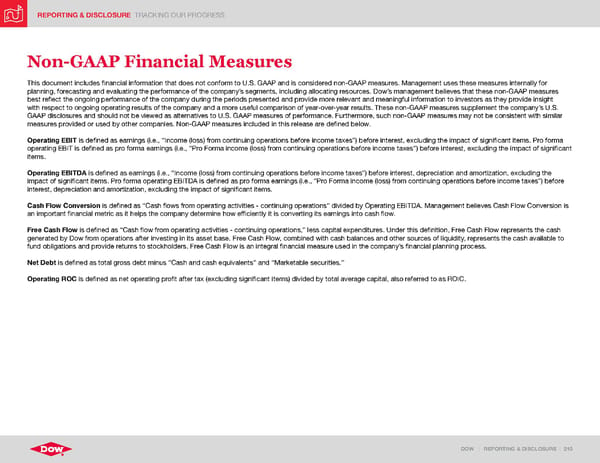REPORTING & DISCLOSURE TRACKING OUR PROGRESS DOW | REPORTING & DISCLOSURE | 210 Non-GAAP Financial Measures This document includes financial information that does not conform to U.S. GAAP and is considered non-GAAP measures. Management uses these measures internally for planning, forecasting and evaluating the performance of the company’s segments, including allocating resources. Dow’s management believes that these non-GAAP measures best reflect the ongoing performance of the company during the periods presented and provide more relevant and meaningful information to investors as they provide insight with respect to ongoing operating results of the company and a more useful comparison of year-over-year results. These non-GAAP measures supplement the company’s U.S. GAAP disclosures and should not be viewed as alternatives to U.S. GAAP measures of performance. Furthermore, such non-GAAP measures may not be consistent with similar measures provided or used by other companies. Non-GAAP measures included in this release are defined below. Operating EBIT is defined as earnings (i.e., “Income (loss) from continuing operations before income taxes”) before interest, excluding the impact of significant items. Pro forma operating EBIT is defined as pro forma earnings (i.e., “Pro Forma income (loss) from continuing operations before income taxes”) before interest, excluding the impact of significant items. Operating EBITDA is defined as earnings (i.e., “Income (loss) from continuing operations before income taxes”) before interest, depreciation and amortization, excluding the impact of significant items. Pro forma operating EBITDA is defined as pro forma earnings (i.e., “Pro Forma income (loss) from continuing operations before income taxes”) before interest, depreciation and amortization, excluding the impact of significant items. Cash Flow Conversion is defined as “Cash flows from operating activities - continuing operations” divided by Operating EBITDA. Management believes Cash Flow Conversion is an important financial metric as it helps the company determine how efficiently it is converting its earnings into cash flow. Free Cash Flow is defined as “Cash flow from operating activities - continuing operations,” less capital expenditures. Under this definition, Free Cash Flow represents the cash generated by Dow from operations after investing in its asset base. Free Cash Flow, combined with cash balances and other sources of liquidity, represents the cash available to fund obligations and provide returns to stockholders. Free Cash Flow is an integral financial measure used in the company’s financial planning process. Net Debt is defined as total gross debt minus “Cash and cash equivalents” and “Marketable securities.” Operating ROC is defined as net operating profit after tax (excluding significant items) divided by total average capital, also referred to as ROIC.
 ESG Report | Dow Page 209 Page 211
ESG Report | Dow Page 209 Page 211